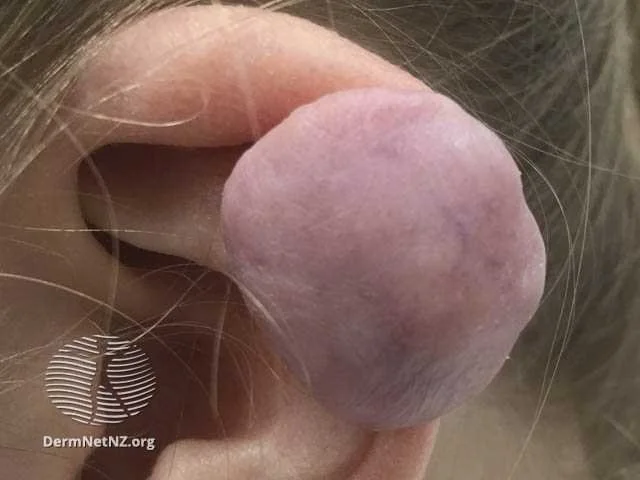
Keloids (Hypertrophic Scars)
An example of a keloid, which is a type of excessively pronounced scar tissue, often raised from the skin like a firm bump.
Credit: DermNet NZ
What are keloids?
A keloid is a raised, often pink or red, growth that results from an overactive scar tissue response. These growths can arise shortly after an injury or may appear months later, often expanding beyond the original injury's boundary. Though keloids are benign, they are generally painless.
What causes keloids?
The exact mechanism behind the exaggerated scar tissue response leading to keloids remains unclear, but genetics play a significant part. African Americans are particularly susceptible to keloid formation, with Asians and Latinos also having an increased predisposition. Common sites for keloid development include the earlobes, chest, back, shoulders, pelvic area, and collar bone.
What are the symptoms of keloids?
Keloids manifest as an enlarged growth that is larger than the initial scar and varies in shade from pink to red. They might emerge from wounds caused by piercings, acne, scratches, or even spontaneously without any preceding injury. While generally not painful, keloids can sometimes be sensitive, especially when exposed to substances like chlorine. There's also a possibility for them to become itchy.
How do I treat keloids?
Although keloids might diminish over time without intervention, various treatments can expedite the process or improve their appearance. These treatments include:
Application of topical steroids or imiquimod
Use of pressure dressings
Injections of steroids directly into the keloid
Administration of 5-Fluorouracil (5-FU) injections
Surgical removal (with a note of caution as there's a notable risk of keloid recurrence post-surgery)
Radiation
How do I prevent keloids?
To minimize the risk of developing keloids, it's advisable to steer clear of elective surgeries, piercings, and tattoos. For individuals prone to keloid formation, early intervention in cases of acne or infections can mitigate the potential of scarring.
Keloids on the chest, which are common after acne breakouts.
Credit: DermNet NZ
Keloids on the ears from piercings can be very severe.
Credit: DermNet NZ



